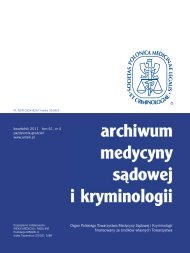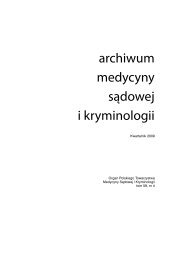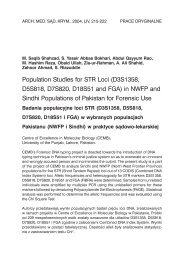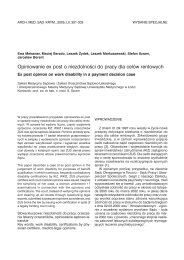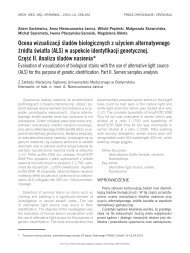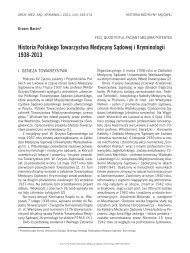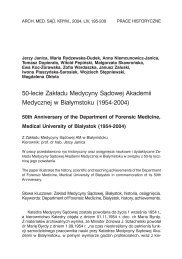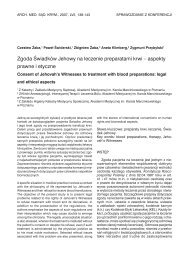PeÅny numer do pobrania (*.pdf) - Archiwum Medycyny SÄ dowej i ...
PeÅny numer do pobrania (*.pdf) - Archiwum Medycyny SÄ dowej i ...
PeÅny numer do pobrania (*.pdf) - Archiwum Medycyny SÄ dowej i ...
You also want an ePaper? Increase the reach of your titles
YUMPU automatically turns print PDFs into web optimized ePapers that Google loves.
88 Łukasz Szleszkowski, Agata Thannhäuser, Jerzy Kawecki, Krzysztof Szwagrzyk, Barbara Świątek<br />
Nr 2<br />
erosion did not allow for finding bullet wounds in<br />
the bones. In the remaining single case, the degree<br />
of massively eroded cranium preservation only indicated<br />
possible cranial fractures, but without any<br />
possibility of confirmation. Apart from the above<br />
cases, the medico-legal analysis confirmed the<br />
archival data on executing ”the death penalty by<br />
shooting” in 38 prisoners interred in the cemetery<br />
fields in question. Additionally, in a single case, the<br />
investigators noted gunshot injuries involving the<br />
head, although such circumstances were not indicated<br />
by archival data on capital punishment execution.<br />
Single gunshots were observed in 14 cases. In<br />
24 cases (approximately 63%), multiple gunshots<br />
were unquestionably determined. In several cases,<br />
the results of inspection pointed to possible multiple<br />
gunshots, but in view of the state of the skeletons<br />
(advanced bone erosion), the hypothesis could<br />
not have been confirmed. In addition, in three<br />
cases, corroded riffle bullets were noted in the<br />
graves (one of them inside the cranium). Isolated<br />
gunshot head injuries were seen in 31 cases. In the<br />
remaining seven cases, gunshot injuries to the head<br />
were accompanied by gunshot wounds of other<br />
areas, such as the cervical spine [4]; upper extremities<br />
[3] and lower extremities [1]. In one case,<br />
apart from a gunshot wound to the head, there<br />
were also noted gunshot injuries involving an upper<br />
extremity and cervical spine. In none of the cases<br />
subjected to the medico-legal analysis did the investigators<br />
note isolated gunshot injuries of body<br />
areas other than the head, e.g. the trunk. In single<br />
cases, gunshot head injuries were accompanied by<br />
injuries inflicted by blunt or blunt-edged tools, e.g.<br />
mandibular fractures. In some cases, the measurement<br />
of bullet wounds did not allow for identifying<br />
bullet caliber in view of coexisting fractures, absence<br />
of bone fragments, bone erosion, diastasis of<br />
the cranial sutures or displacement of bone fragments<br />
in consequence of taphonomic processes.<br />
The size of bullet wounds in cases when they might<br />
have been used in determining bullet caliber were<br />
within a range of 0.7-09 cm, and pre<strong>do</strong>minantly in<br />
the 0.75-0.8 cm range. In approximately one half<br />
of cases, gunshot injuries were accompanied by extensive<br />
comminuted fractures of the cranial bones.<br />
In 34 cases (89%) it was possible to distinguish at<br />
least one type of bullet wounds or their part (entrance<br />
or exit); in infrequent cases, only the arrangement<br />
of bone fracture fissures allowed for<br />
drawing conclusions as to their location. In view of<br />
extensive cranial fracturing, prior to inspection,<br />
bone fragments were glued together, what allowed<br />
for visualizing bullet wounds 2 .<br />
The analyzed material also demonstrated atypical<br />
gunshot injuries. In two cases, atypical keyhole-type<br />
bullet wounds were noted in the cranial<br />
vertex, what indicated a tangential gunshot to the<br />
head [2]. In one case, in the parietal region, the investigators<br />
noted a <strong>do</strong>uble bullet wound shaped approximately<br />
as the <strong>numer</strong>al ”8”, which most likely<br />
occurred in consequence of two bullets having been<br />
fired at a single shot (tandem shot) due to the<br />
firearm being faulty or – what is less likely – of the<br />
shooter using a shooting technique consisting in firing<br />
two shots immediately one after another [2]. In<br />
some cases, no typical exit bullet wounds were<br />
found, but rather comminuted fractures (especially<br />
of the cranio-facial bones) that might correspond<br />
to the so-called hidden exits [3, 2]; this phenomenon<br />
may be related to both the anatomical location<br />
of the exit wound within the region with small cranial<br />
bones and to a multiple gunshot, when the first<br />
shot resulted in a comminuted fracture of the cranial<br />
bones and the second bullet that subsequently<br />
penetrated the cranium did not form a typical exit<br />
wound but left the skull among bone fragments,<br />
thus forming an ”obliterated” exit wound.<br />
Below, the investigators present conclusions resulting<br />
from the medico-legal inspection of selected<br />
interesting cases. Reconstructions af execution<br />
course based solely on bones inspection should be<br />
treated as one of possible courses of the analyzed<br />
event.<br />
2<br />
The investigators used rayon acrylic glue-coated adhesive strips normally employed in keeping in place large and heavy dressings. The adhesive strips<br />
were effective under field conditions and allowed for gluing together bone fragments provided they were cleaned and dry.<br />
2012 © by Polskie Towarzystwo <strong>Medycyny</strong> Są<strong>do</strong>wej i Kryminologii, ISSN 0324-8267



